2007 ISUZU KB P190 service
[x] Cancel search: servicePage 5657 of 6020
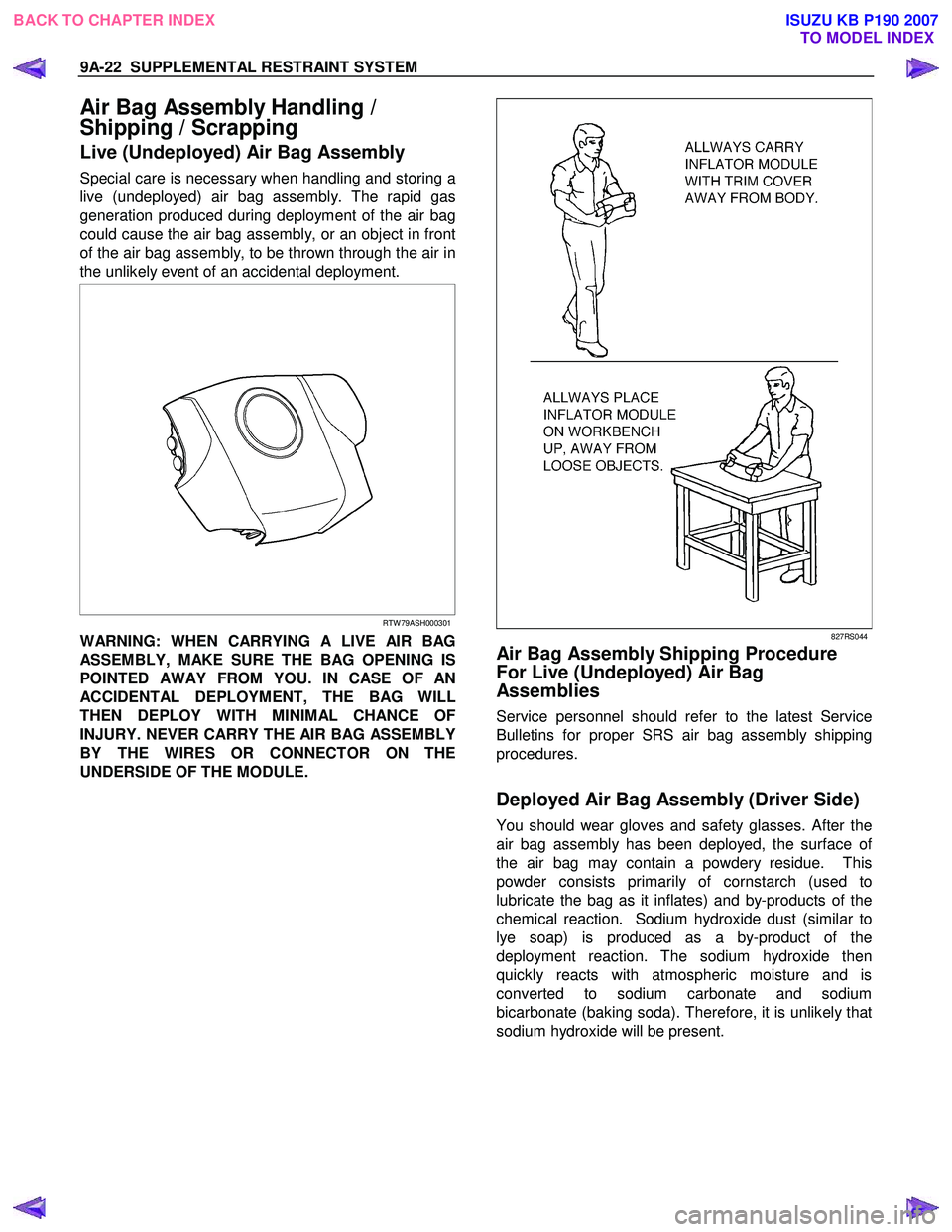
9A-22 SUPPLEMENTAL RESTRAINT SYSTEM
Air Bag Assembly Handling /
Shipping / Scrapping
Live (Undeployed) Air Bag Assembly
Special care is necessary when handling and storing a
live (undeployed) air bag assembly. The rapid gas
generation produced during deployment of the air bag
could cause the air bag assembly, or an object in front
of the air bag assembly, to be thrown through the air in
the unlikely event of an accidental deployment.
RTW 79ASH000301
WARNING: WHEN CARRYING A LIVE AIR BAG
ASSEMBLY, MAKE SURE THE BAG OPENING IS
POINTED AWAY FROM YOU. IN CASE OF AN
ACCIDENTAL DEPLOYMENT, THE BAG WILL
THEN DEPLOY WITH MINIMAL CHANCE OF
INJURY. NEVER CARRY THE AIR BAG ASSEMBLY
BY THE WIRES OR CONNECTOR ON THE
UNDERSIDE OF THE MODULE.
827RS044
Air Bag Assembly Shipping Procedure
For Live (Undeployed) Air Bag
Assemblies
Service personnel should refer to the latest Service
Bulletins for proper SRS air bag assembly shipping
procedures.
Deployed Air Bag Assembly (Driver Side)
You should wear gloves and safety glasses. After the
air bag assembly has been deployed, the surface o
f
the air bag may contain a powdery residue. This
powder consists primarily of cornstarch (used to
lubricate the bag as it inflates) and by-products of the
chemical reaction. Sodium hydroxide dust (similar to
lye soap) is produced as a by-product of the
deployment reaction. The sodium hydroxide then
quickly reacts with atmospheric moisture and is
converted to sodium carbonate and sodium
bicarbonate (baking soda). Therefore, it is unlikely that
sodium hydroxide will be present.
BACK TO CHAPTER INDEX TO MODEL INDEXISUZU KB P190 2007
Page 5658 of 6020
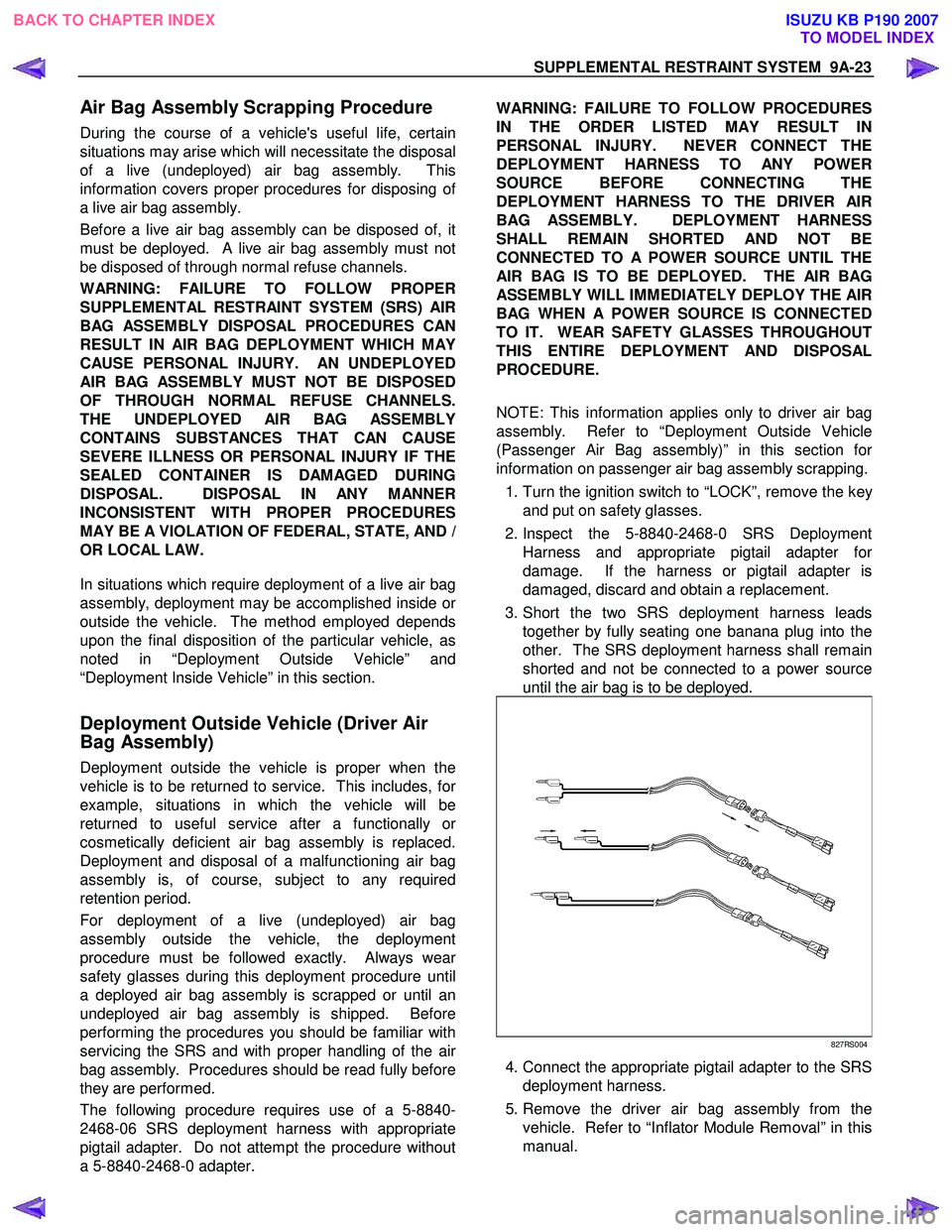
SUPPLEMENTAL RESTRAINT SYSTEM 9A-23
Air Bag Assembly Scrapping Procedure
During the course of a vehicle's useful life, certain
situations may arise which will necessitate the disposal
of a live (undeployed) air bag assembly. This
information covers proper procedures for disposing o
f
a live air bag assembly.
Before a live air bag assembly can be disposed of, it
must be deployed.
A live air bag assembly must not
be disposed of through normal refuse channels.
WARNING: FAILURE TO FOLLOW PROPER
SUPPLEMENTAL RESTRAINT SYSTEM (SRS) AIR
BAG ASSEMBLY DISPOSAL PROCEDURES CAN
RESULT IN AIR BAG DEPLOYMENT WHICH MAY
CAUSE PERSONAL INJURY. AN UNDEPLOYED
AIR BAG ASSEMBLY MUST NOT BE DISPOSED
OF THROUGH NORMAL REFUSE CHANNELS.
THE UNDEPLOYED AIR BAG ASSEMBLY
CONTAINS SUBSTANCES THAT CAN CAUSE
SEVERE ILLNESS OR PERSONAL INJURY IF THE
SEALED CONTAINER IS DAMAGED DURING
DISPOSAL. DISPOSAL IN ANY MANNER
INCONSISTENT WITH PROPER PROCEDURES
MAY BE A VIOLATION OF FEDERAL, STATE, AND
/
OR LOCAL LAW.
In situations which require deployment of a live air bag
assembly, deployment may be accomplished inside o
r
outside the vehicle. The method employed depends
upon the final disposition of the particular vehicle, as
noted in “Deployment Outside Vehicle” and
“Deployment Inside Vehicle” in this section.
Deployment Outside Vehicle (Driver Air
Bag Assembly)
Deployment outside the vehicle is proper when the
vehicle is to be returned to service. This includes, fo
r
example, situations in which the vehicle will be
returned to useful service after a functionally o
r
cosmetically deficient air bag assembly is replaced.
Deployment and disposal of a malfunctioning air bag
assembly is, of course, subject to any required
retention period.
For deployment of a live (undeployed) air bag
assembly outside the vehicle, the deployment
procedure must be followed exactly. Always wea
r
safety glasses during this deployment procedure until
a deployed air bag assembly is scrapped or until an
undeployed air bag assembly is shipped. Before
performing the procedures you should be familiar with
servicing the SRS and with proper handling of the ai
r
bag assembly. Procedures should be read fully before
they are performed.
The following procedure requires use of a 5-8840-
2468-06 SRS deployment harness with appropriate
pigtail adapter. Do not attempt the procedure without
a 5-8840-2468-0 adapter.
WARNING: F
AILURE TO FOLLOW PROCEDURES
IN THE ORDER LISTED MAY RESULT IN
PERSONAL INJURY. NEVER CONNECT THE
DEPLOYMENT HARNESS TO ANY POWER
SOURCE BEFORE CONNECTING THE
DEPLOYMENT HARNESS TO THE DRIVER AIR
BAG ASSEMBLY. DEPLOYMENT HARNESS
SHALL REMAIN SHORTED AND NOT BE
CONNECTED TO A POWER SOURCE UNTIL THE
AIR BAG IS TO BE DEPLOYED. THE AIR BAG
ASSEMBLY WILL IMMEDIATELY DEPLOY THE AIR
BAG WHEN A POWER SOURCE IS CONNECTED
TO IT. WEAR SAFETY GLASSES THROUGHOUT
THIS ENTIRE DEPLOYMENT AND DISPOSAL
PROCEDURE.
NOTE: This information applies only to driver air bag
assembly. Refer to “Deployment Outside Vehicle
(Passenger Air Bag assembly)” in this section fo
r
information on passenger air bag assembly scrapping.
1. Turn the ignition switch to “LOCK”, remove the ke
y
and put on safety glasses.
2. Inspect the 5-8840-2468-0 SRS Deployment Harness and appropriate pigtail adapter fo
r
damage. If the harness or pigtail adapter is
damaged, discard and obtain a replacement.
3. Short the two SRS deployment harness leads together by fully seating one banana plug into the
other. The SRS deployment harness shall remain
shorted and not be connected to a power source
until the air bag is to be deployed.
827RS004
4. Connect the appropriate pigtail adapter to the SRS deployment harness.
5. Remove the driver air bag assembly from the vehicle. Refer to “Inflator Module Removal” in this
manual.
BACK TO CHAPTER INDEX TO MODEL INDEXISUZU KB P190 2007
Page 5661 of 6020
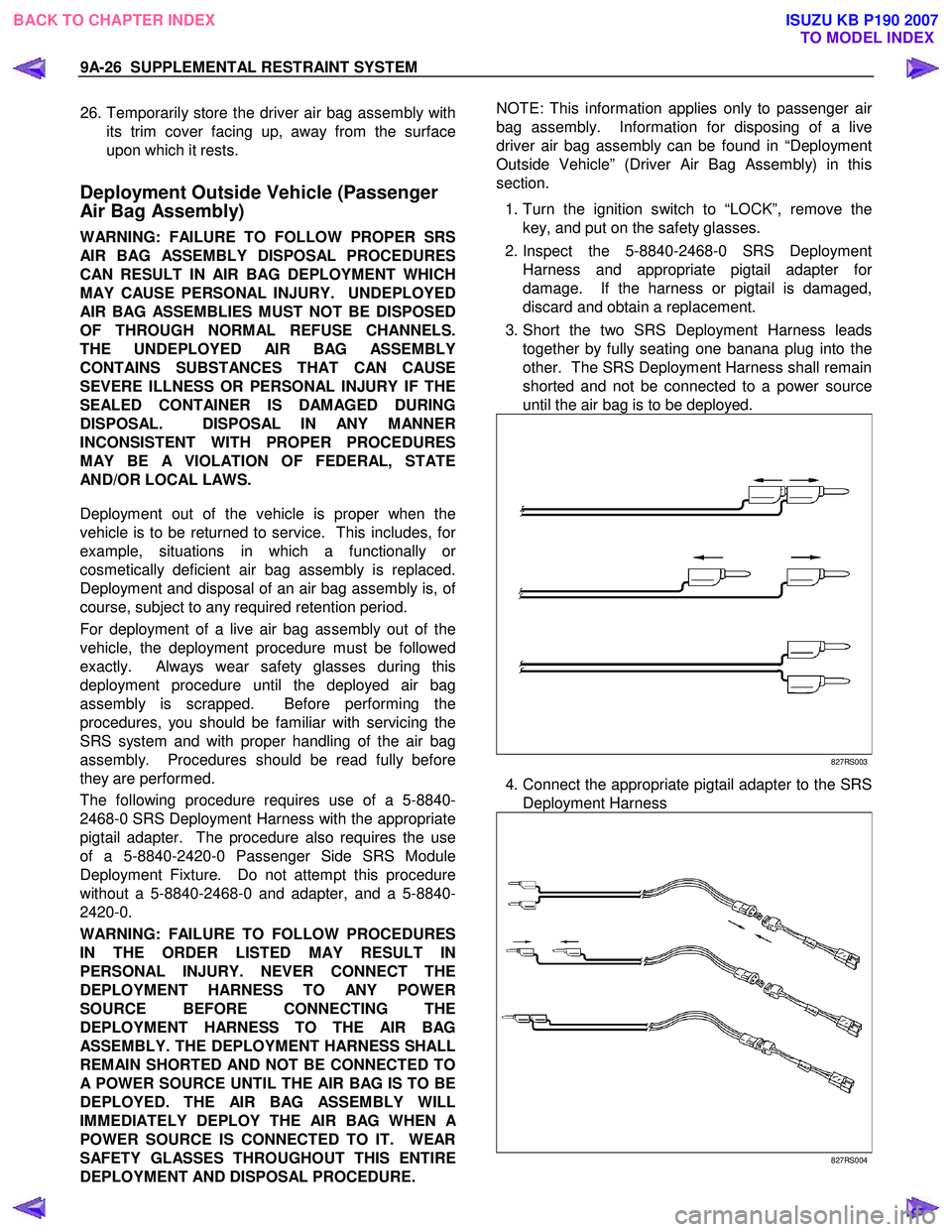
9A-26 SUPPLEMENTAL RESTRAINT SYSTEM
26. Temporarily store the driver air bag assembly with
its trim cover facing up, away from the surface
upon which it rests.
Deployment Outside Vehicle (Passenger
Air Bag Assembly)
WARNING: FAILURE TO FOLLOW PROPER SRS
AIR BAG ASSEMBLY DISPOSAL PROCEDURES
CAN RESULT IN AIR BAG DEPLOYMENT WHICH
MAY CAUSE PERSONAL INJURY. UNDEPLOYED
AIR BAG ASSEMBLIES MUST NOT BE DISPOSED
OF THROUGH NORMAL REFUSE CHANNELS.
THE UNDEPLOYED AIR BAG ASSEMBLY
CONTAINS SUBSTANCES THAT CAN CAUSE
SEVERE ILLNESS OR PERSONAL INJURY IF THE
SEALED CONTAINER IS DAMAGED DURING
DISPOSAL. DISPOSAL IN ANY MANNER
INCONSISTENT WITH PROPER PROCEDURES
MAY BE A VIOLATION OF FEDERAL, STATE
AND/OR LOCAL LAWS.
Deployment out of the vehicle is proper when the
vehicle is to be returned to service. This includes, fo
r
example, situations in which a functionally or
cosmetically deficient air bag assembly is replaced.
Deployment and disposal of an air bag assembly is, o
f
course, subject to any required retention period.
For deployment of a live air bag assembly out of the
vehicle, the deployment procedure must be followed
exactly. Always wear safety glasses during this
deployment procedure until the deployed air bag
assembly is scrapped. Before performing the
procedures, you should be familiar with servicing the
SRS system and with proper handling of the air bag
assembly. Procedures should be read fully before
they are performed.
The following procedure requires use of a 5-8840-
2468-0 SRS Deployment Harness with the appropriate
pigtail adapter. The procedure also requires the use
of a 5-8840-2420-0 Passenger Side SRS Module
Deployment Fixture. Do not attempt this procedure
without a 5-8840-2468-0 and adapter, and a 5-8840-
2420-0.
WARNING: FAILURE TO FOLLOW PROCEDURES
IN THE ORDER LISTED MA
Y RESULT IN
PERSONAL INJURY. NEVER CONNECT THE
DEPLOYMENT HARNESS TO ANY POWER
SOURCE BEFORE CONNECTING THE
DEPLOYMENT HARNESS TO THE AIR BAG
ASSEMBLY. THE DEPLOYMENT HARNESS SHALL
REMAIN SHORTED AND NOT BE CONNECTED TO
A POWER SOURCE UNTIL THE AIR BAG IS TO BE
DEPLOYED. THE AIR BAG ASSEMBLY WILL
IMMEDIATELY DEPLOY THE AIR BAG WHEN
A
POWER SOURCE IS CONNECTED TO IT. WEAR
SAFETY GLASSES THROUGHOUT THIS ENTIRE
DEPLOYMENT AND DISPOSAL PROCEDURE.
NOTE: This information applies only to passenger ai
r
bag assembly. Information for disposing of a live
driver air bag assembly can be found in “Deployment
Outside Vehicle” (Driver Air Bag Assembly) in this
section.
1. Turn the ignition switch to “LOCK”, remove the key, and put on the safety glasses.
2. Inspect the 5-8840-2468-0 SRS Deployment Harness and appropriate pigtail adapter fo
r
damage. If the harness or pigtail is damaged,
discard and obtain a replacement.
3. Short the two SRS Deployment Harness leads together by fully seating one banana plug into the
other. The SRS Deployment Harness shall remain
shorted and not be connected to a power source
until the air bag is to be deployed.
827RS003
4. Connect the appropriate pigtail adapter to the SRS Deployment Harness
827RS004
BACK TO CHAPTER INDEX TO MODEL INDEXISUZU KB P190 2007
Page 5667 of 6020
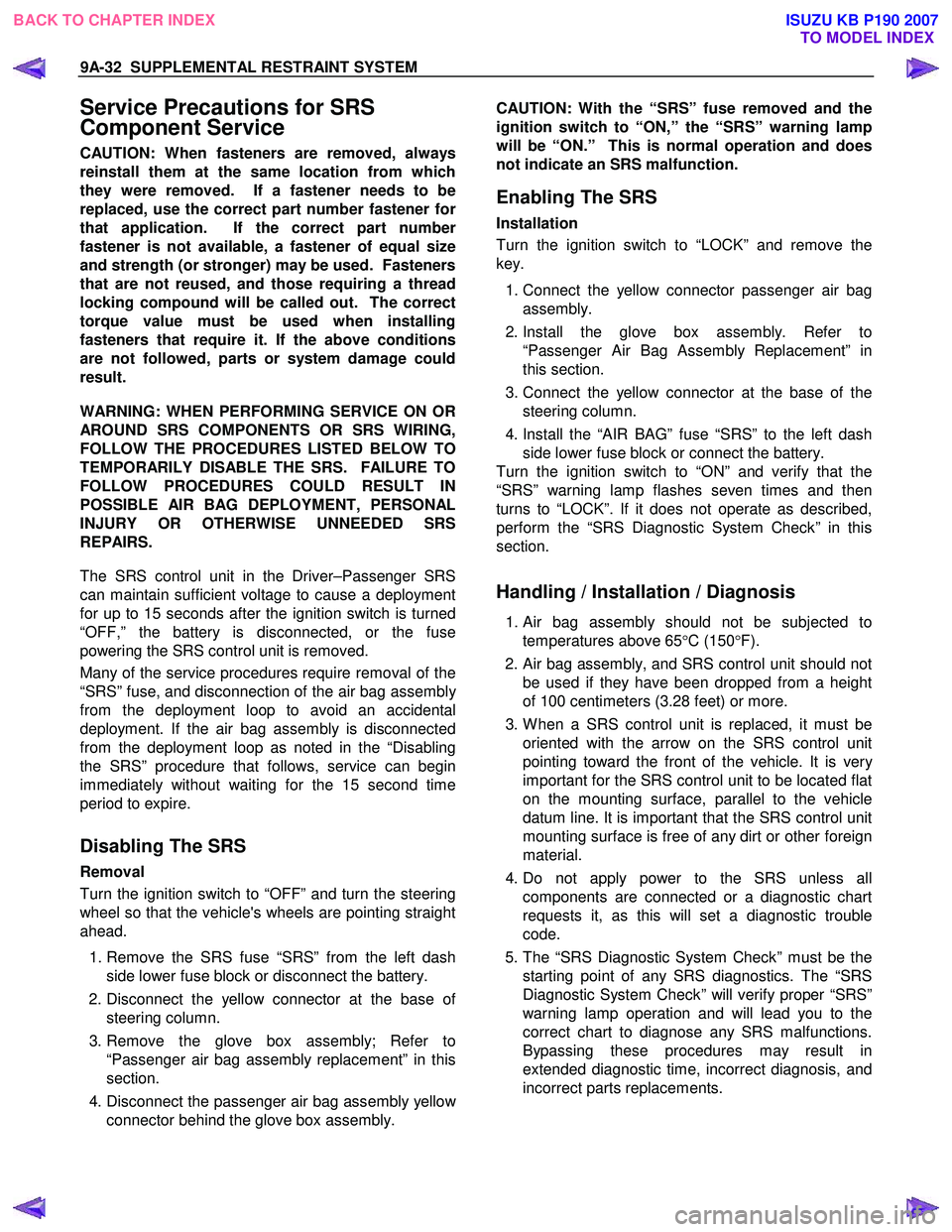
9A-32 SUPPLEMENTAL RESTRAINT SYSTEM
Service Precautions for SRS
Component Service
CAUTION: When fasteners are removed, always
reinstall them at the same location from which
they were removed. If a fastener needs to be
replaced, use the correct part number fastener fo
r
that application. If the correct part number
fastener is not available, a fastener of equal size
and strength (or stronger) may be used. Fasteners
that are not reused, and those requiring a thread
locking compound will be called out. The correct
torque value must be used when installing
fasteners that require it. If the above conditions
are not followed, parts or system damage could
result.
WARNING: WHEN PERFORMING SERVICE ON OR
AROUND SRS COMPONENTS OR SRS WIRING,
FOLLOW THE PROCEDURES LISTED BELOW TO
TEMPORARILY DISABLE THE SRS. FAILURE TO
FOLLOW PROCEDURES COULD RESULT IN
POSSIBLE AIR BAG DEPLOYMENT, PERSONAL
INJURY OR OTHERWISE UNNEEDED SRS
REPAIRS.
The SRS control unit in the Driver–Passenger SRS
can maintain sufficient voltage to cause a deployment
for up to 15 seconds after the ignition switch is turned
“OFF,” the battery is disconnected, or the fuse
powering the SRS control unit is removed.
Many of the service procedures require removal of the
“SRS” fuse, and disconnection of the air bag assembl
y
from the deployment loop to avoid an accidental
deployment. If the air bag assembly is disconnected
from the deployment loop as noted in the “Disabling
the SRS” procedure that follows, service can begin
immediately without waiting for the 15 second time
period to expire.
Disabling The SRS
Removal
Turn the ignition switch to “OFF” and turn the steering
wheel so that the vehicle's wheels are pointing straight
ahead.
1. Remove the SRS fuse “SRS” from the left dash side lower fuse block or disconnect the battery.
2. Disconnect the yellow connector at the base o
f
steering column.
3. Remove the glove box assembly; Refer to “Passenger air bag assembly replacement” in this
section.
4. Disconnect the passenger air bag assembly yello
w
connector behind the glove box assembly.
CAUTION: With the “SRS” fuse removed and the
ignition switch to “ON,” the “SRS” warning lamp
will be “ON.” This is normal operation and does
not indicate an SRS malfunction.
Enabling The SRS
Installation
Turn the ignition switch to “LOCK” and remove the
key.
1. Connect the yellow connector passenger air bag assembly.
2. Install the glove box assembly. Refer to “Passenger Air Bag Assembly Replacement” in
this section.
3. Connect the yellow connector at the base of the steering column.
4. Install the “AIR BAG” fuse “SRS” to the left dash side lower fuse block or connect the battery.
Turn the ignition switch to “ON” and verify that the
“SRS” warning lamp flashes seven times and then
turns to “LOCK”. If it does not operate as described,
perform the “SRS Diagnostic System Check” in this
section.
Handling / Installation / Diagnosis
1. Air bag assembly should not be subjected to
temperatures above 65 °C (150 °F).
2.
Air bag assembly, and SRS control unit should not
be used if they have been dropped from a height
of 100 centimeters (3.28 feet) or more.
3. W hen a SRS control unit is replaced, it must be oriented with the arrow on the SRS control unit
pointing toward the front of the vehicle. It is ver
y
important for the SRS control unit to be located flat
on the mounting surface, parallel to the vehicle
datum line. It is important that the SRS control unit
mounting surface is free of any dirt or other foreign
material.
4. Do not apply power to the SRS unless all components are connected or a diagnostic chart
requests it, as this will set a diagnostic trouble
code.
5. The “SRS Diagnostic System Check” must be the starting point of any SRS diagnostics. The “SRS
Diagnostic System Check” will verify proper “SRS”
warning lamp operation and will lead you to the
correct chart to diagnose any SRS malfunctions.
Bypassing these procedures may result in
extended diagnostic time, incorrect diagnosis, and
incorrect parts replacements.
BACK TO CHAPTER INDEX TO MODEL INDEXISUZU KB P190 2007
Page 5668 of 6020
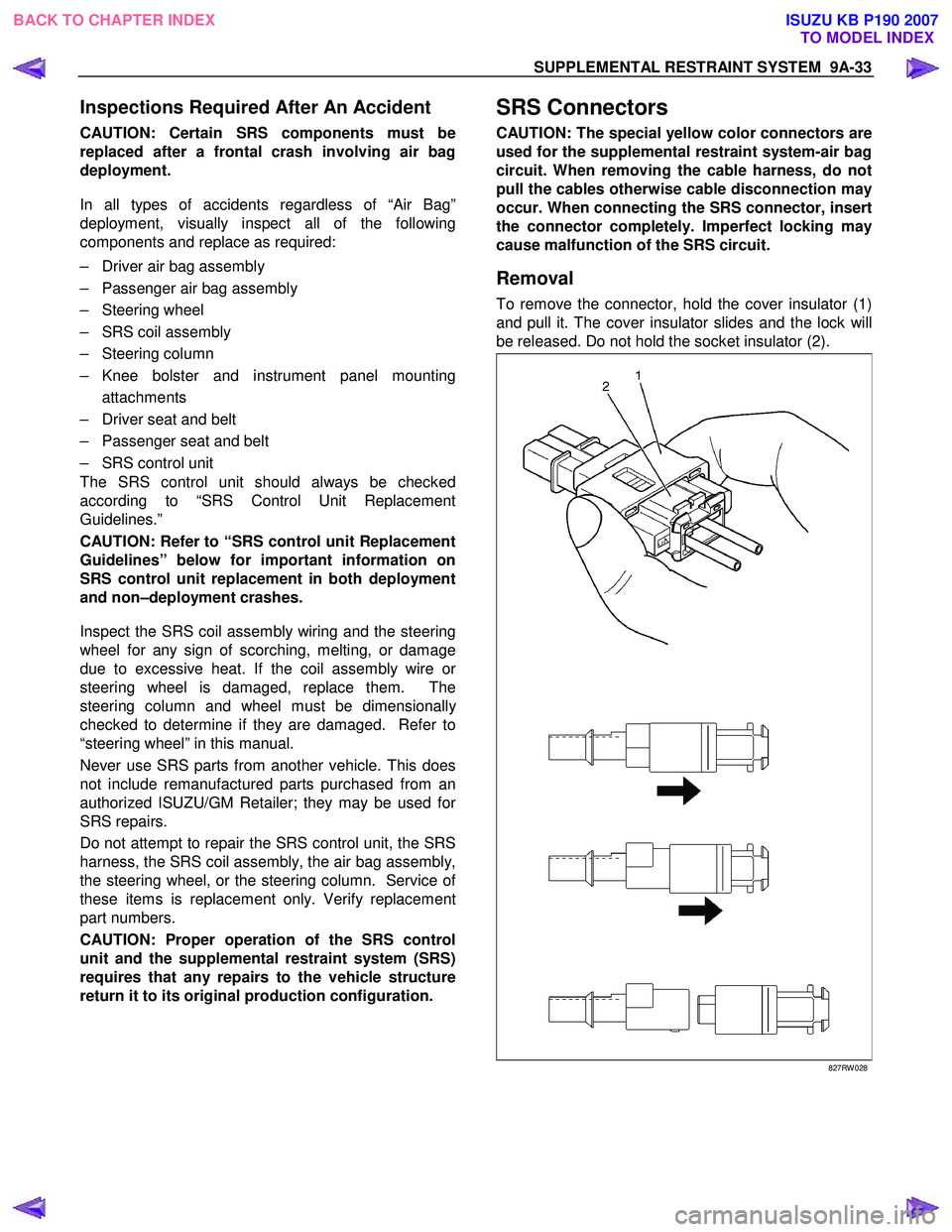
SUPPLEMENTAL RESTRAINT SYSTEM 9A-33
Inspections Required After An Accident
CAUTION: Certain SRS components must be
replaced after a frontal crash involving air bag
deployment.
In all types of accidents regardless of “Air Bag”
deployment, visually inspect all of the following
components and replace as required:
– Driver air bag assembly
– Passenger air bag assembly
– Steering wheel
– SRS coil assembly
– Steering column
– Knee bolster and instrument panel mounting attachments
– Driver seat and belt
– Passenger seat and belt
– SRS control unit
The SRS control unit should always be checked
according to “SRS Control Unit Replacement
Guidelines.”
CAUTION: Refer to “SRS control unit Replacement
Guidelines” below for important information on
SRS control unit replacement in both deployment
and non–deployment crashes.
Inspect the SRS coil assembly wiring and the steering
wheel for any sign of scorching, melting, or damage
due to excessive heat. If the coil assembly wire o
r
steering wheel is damaged, replace them. The
steering column and wheel must be dimensionall
y
checked to determine if they are damaged. Refer to
“steering wheel” in this manual.
Never use SRS parts from another vehicle. This does
not include remanufactured parts purchased from an
authorized ISUZU/GM Retailer; they may be used fo
r
SRS repairs.
Do not attempt to repair the SRS control unit, the SRS
harness, the SRS coil assembly, the air bag assembly,
the steering wheel, or the steering column. Service o
f
these items is replacement only. Verify replacement
part numbers.
CAUTION: Proper operation of the SRS control
unit and the supplemental restraint system (SRS)
requires that any repairs to the vehicle structure
return it to its original production configuration.
SRS Connectors
CAUTION: The special yellow color connectors are
used for the supplemental restraint system-air bag
circuit. When removing the cable harness, do not
pull the cables otherwise cable disconnection may
occur. When connecting the SRS connector, insert
the connector completely. Imperfect locking may
cause malfunction of the SRS circuit.
Removal
To remove the connector, hold the cover insulator (1)
and pull it. The cover insulator slides and the lock will
be released. Do not hold the socket insulator (2).
827RW 028
BACK TO CHAPTER INDEX TO MODEL INDEXISUZU KB P190 2007
Page 5670 of 6020
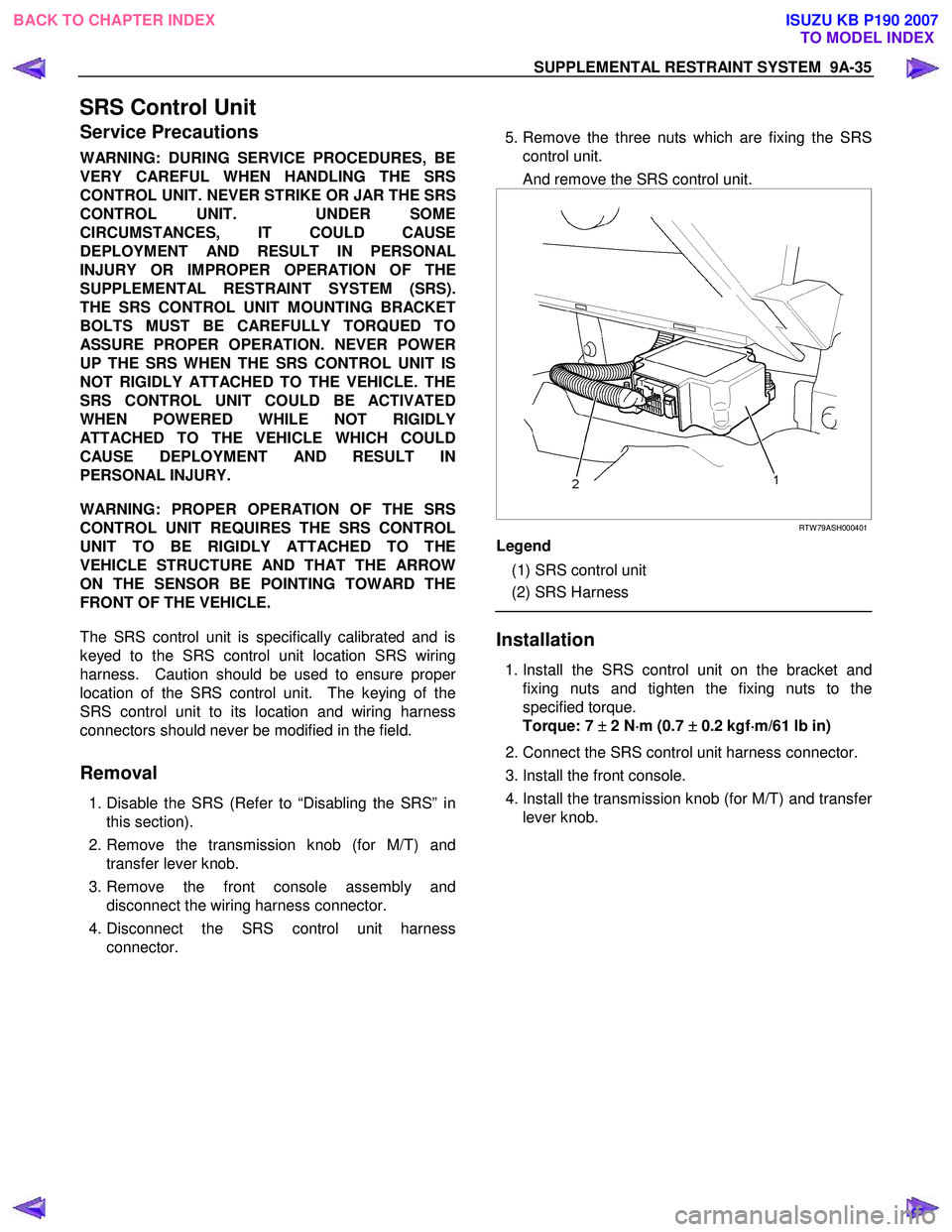
SUPPLEMENTAL RESTRAINT SYSTEM 9A-35
SRS Control Unit
Service Precautions
WARNING: DURING SERVICE PROCEDURES, BE
VERY CAREFUL WHEN HANDLING THE SRS
CONTROL UNIT. NEVER STRIKE OR JAR THE SRS
CONTROL UNIT. UNDER SOME
CIRCUMSTANCES, IT COULD CAUSE
DEPLOYMENT AND RESULT IN PERSONAL
INJURY OR IMPROPER OPERATION OF THE
SUPPLEMENTAL RESTRAINT SYSTEM (SRS).
THE SRS CONTROL UNIT MOUNTING BRACKET
BOLTS MUST BE CAREFULLY TORQUED TO
ASSURE PROPER OPERATION. NEVER POWER
UP THE SRS WHEN THE SRS CONTROL UNIT IS
NOT RIGIDLY ATTACHED TO THE VEHICLE. THE
SRS CONTROL UNIT COULD BE ACTIVATED
WHEN POWERED WHILE NOT RIGIDLY
ATTACHED TO THE VEHICLE WHICH COULD
CAUSE DEPLOYMENT AND RESULT IN
PERSONAL INJURY.
WARNING: PROPER OPERATION OF THE SRS
CONTROL UNIT REQUIRES THE SRS CONTROL
UNIT TO BE RIGIDLY ATTACHED TO THE
VEHICLE STRUCTURE AND THAT THE ARROW
ON THE SENSOR BE POINTING TOWARD THE
FRONT OF THE VEHICLE.
The SRS control unit is specifically calibrated and is
keyed to the SRS control unit location SRS wiring
harness. Caution should be used to ensure prope
r
location of the SRS control unit. The keying of the
SRS control unit to its location and wiring harness
connectors should never be modified in the field.
Removal
1. Disable the SRS (Refer to “Disabling the SRS” in this section).
2. Remove the transmission knob (for M/T) and transfer lever knob.
3. Remove the front console assembly and disconnect the wiring harness connector.
4. Disconnect the SRS control unit harness connector.
5. Remove the three nuts which are fixing the SRS
control unit.
And remove the SRS control unit.
RTW 79ASH000401
Legend
(1) SRS control unit
(2) SRS Harness
Installation
1. Install the SRS control unit on the bracket and
fixing nuts and tighten the fixing nuts to the
specified torque.
Torque: 7 ±
±±
±
2 N ⋅
⋅⋅
⋅
m (0.7 ±
±±
±
0.2 kgf ⋅
⋅⋅
⋅
m/61 lb in)
2. Connect the SRS control unit harness connector.
3. Install the front console.
4. Install the transmission knob (for M/T) and transfe
r
lever knob.
BACK TO CHAPTER INDEX TO MODEL INDEXISUZU KB P190 2007
Page 5672 of 6020
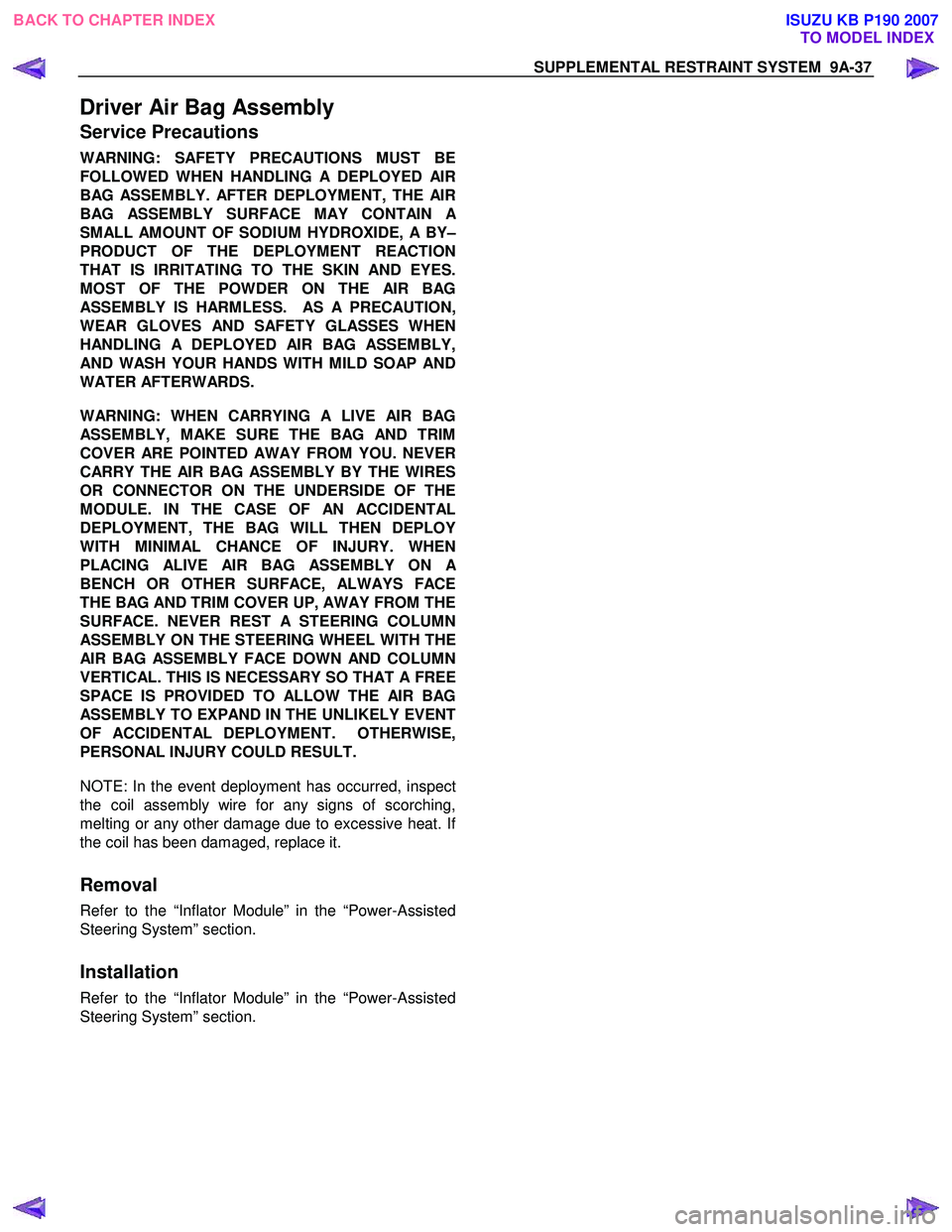
SUPPLEMENTAL RESTRAINT SYSTEM 9A-37
Driver Air Bag Assembly
Service Precautions
WARNING: SAFETY PRECAUTIONS MUST BE
FOLLOWED WHEN HANDLING A DEPLOYED AIR
BAG ASSEMBLY. AFTER DEPLOYMENT, THE AIR
BAG ASSEMBLY SURFACE MAY CONTAIN
A
SMALL AMOUNT OF SODIUM HYDROXIDE, A BY–
PRODUCT OF THE DEPLOYMENT REACTION
THAT IS IRRITATING TO THE SKIN AND EYES.
MOST OF THE POWDER ON THE AIR BAG
ASSEMBLY IS HARMLESS. AS A PRECAUTION,
WEAR GLOVES AND SAFETY GLASSES WHEN
HANDLING A DEPLOYED AIR BAG ASSEMBLY,
AND WASH YOUR HANDS WITH MILD SOAP AND
WATER AFTERWARDS.
WARNING: WHEN CARRYING A LIVE AIR BAG
ASSEMBLY, MAKE SURE THE BAG AND TRIM
COVER ARE POINTED AWAY FROM YOU. NEVER
CARRY THE AIR BAG ASSEMBLY BY THE WIRES
OR CONNECTOR ON THE UNDERSIDE OF THE
MODULE. IN THE CASE OF AN ACCIDENTAL
DEPLOYMENT, THE BAG WILL THEN DEPLOY
WITH MINIMAL CHANCE OF INJURY. WHEN
PLACING ALIVE AIR BAG ASSEMBLY ON
A
BENCH OR OTHER SURFACE, ALWAYS FACE
THE BAG AND TRIM COVER UP, AWAY FROM THE
SURFACE. NEVER REST A STEERING COLUMN
ASSEMBLY ON THE STEERING WHEEL WITH THE
AIR BAG ASSEMBLY FACE DOWN AND COLUMN
VERTICAL. THIS IS NECESSARY SO THAT A FREE
SPACE IS PROVIDED TO ALLOW THE AIR BAG
ASSEMBLY TO EXPAND IN THE UNLIKELY EVENT
OF ACCIDENTAL DEPLOYMENT. OTHERWISE,
PERSONAL INJURY COULD RESULT.
NOTE: In the event deployment has occurred, inspect
the coil assembly wire for any signs of scorching,
melting or any other damage due to excessive heat. I
f
the coil has been damaged, replace it.
Removal
Refer to the “Inflator Module” in the “Power-Assisted
Steering System” section.
Installation
Refer to the “Inflator Module” in the “Power-Assisted
Steering System” section.
BACK TO CHAPTER INDEX
TO MODEL INDEXISUZU KB P190 2007
Page 5673 of 6020
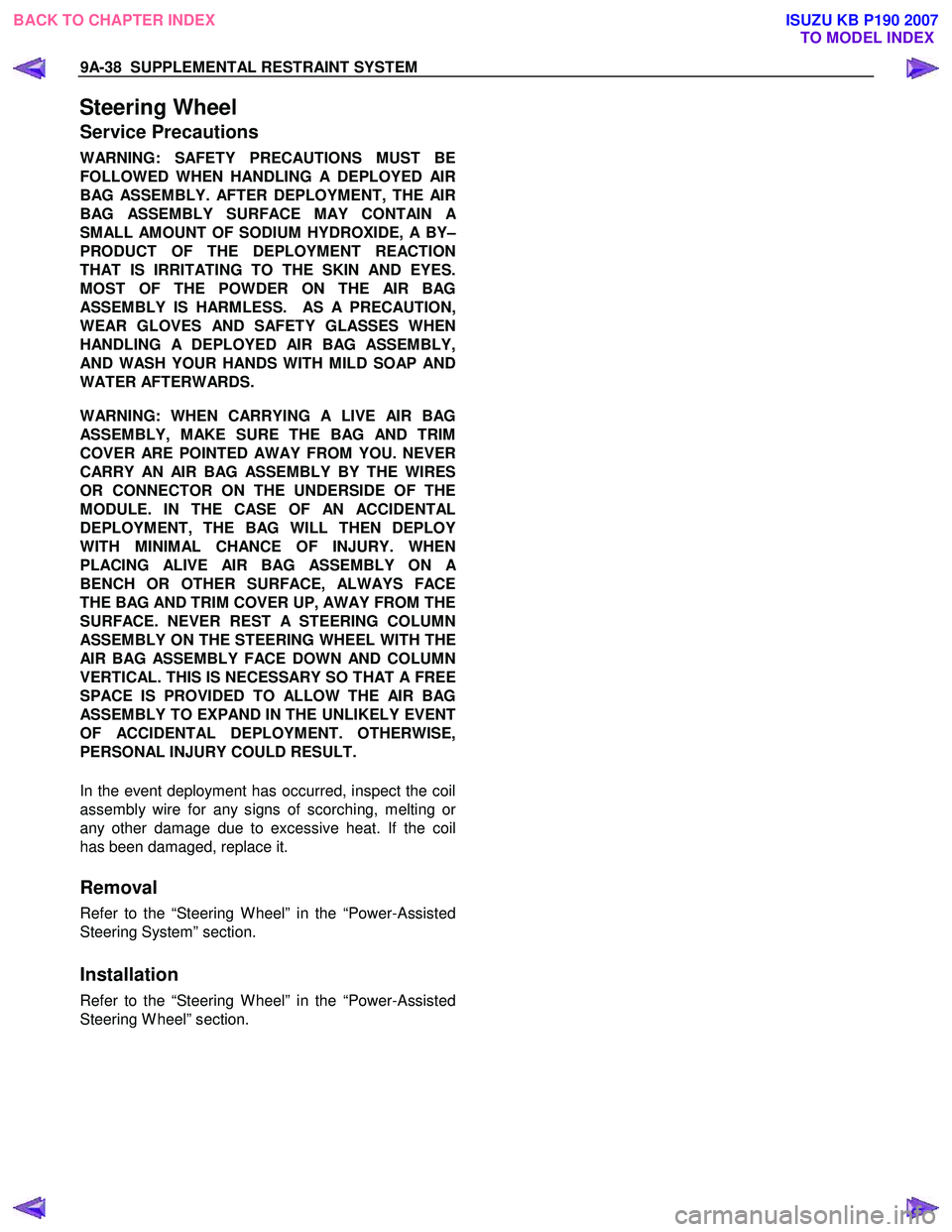
9A-38 SUPPLEMENTAL RESTRAINT SYSTEM
Steering Wheel
Service Precautions
WARNING: SAFETY PRECAUTIONS MUST BE
FOLLOWED WHEN HANDLING A DEPLOYED AIR
BAG ASSEMBLY. AFTER DEPLOYMENT, THE AIR
BAG ASSEMBLY SURFACE MAY CONTAIN
A
SMALL AMOUNT OF SODIUM HYDROXIDE, A BY–
PRODUCT OF THE DEPLOYMENT REACTION
THAT IS IRRITATING TO THE SKIN AND EYES.
MOST OF THE POWDER ON THE AIR BAG
ASSEMBLY IS HARMLESS. AS A PRECAUTION,
WEAR GLOVES AND SAFETY GLASSES WHEN
HANDLING A DEPLOYED AIR BAG ASSEMBLY,
AND WASH YOUR HANDS WITH MILD SOAP AND
WATER AFTERWARDS.
WARNING: WHEN CARRYING A LIVE AIR BAG
ASSEMBLY, MAKE SURE THE BAG AND TRIM
COVER ARE POINTED AWAY FROM YOU. NEVER
CARRY AN AIR BAG ASSEMBLY BY THE WIRES
OR CONNECTOR ON THE UNDERSIDE OF THE
MODULE. IN THE CASE OF AN ACCIDENTAL
DEPLOYMENT, THE BAG WILL THEN DEPLOY
WITH MINIMAL CHANCE OF INJURY. WHEN
PLACING ALIVE AIR BAG ASSEMBLY ON
A
BENCH OR OTHER SURFACE, ALWAYS FACE
THE BAG AND TRIM COVER UP, AWAY FROM THE
SURFACE. NEVER REST A STEERING COLUMN
ASSEMBLY ON THE STEERING WHEEL WITH THE
AIR BAG ASSEMBLY FACE DOWN AND COLUMN
VERTICAL. THIS IS NECESSARY SO THAT A FREE
SPACE IS PROVIDED TO ALLOW THE AIR BAG
ASSEMBLY TO EXPAND IN THE UNLIKELY EVENT
OF ACCIDENTAL DEPLOYMENT. OTHERWISE,
PERSONAL INJURY COULD RESULT.
In the event deployment has occurred, inspect the coil
assembly wire for any signs of scorching, melting o
r
any other damage due to excessive heat. If the coil
has been damaged, replace it.
Removal
Refer to the “Steering W heel” in the “Power-Assisted
Steering System” section.
Installation
Refer to the “Steering W heel” in the “Power-Assisted
Steering W heel” section.
BACK TO CHAPTER INDEX
TO MODEL INDEXISUZU KB P190 2007